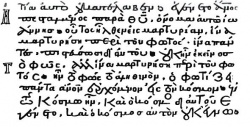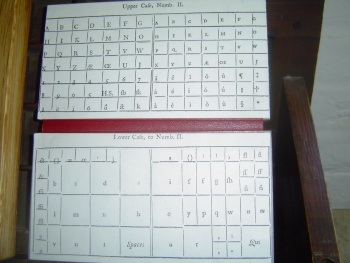Lower case
From Textus Receptus
(→See also) |
|||
| Line 27: | Line 27: | ||
== See also == | == See also == | ||
| - | + | ||
* [[Case folding]] | * [[Case folding]] | ||
* [[Letter case]] | * [[Letter case]] | ||
Revision as of 13:24, 12 October 2011
Lower case (also lower-case or lowercase), minuscule, or small letters are the smaller form of letters, as opposed to upper case or capital letters, as used in European alphabets (Greek, Latin, Cyrillic, and Armenian). For example, the letter "a" is lower case while the letter "A" is upper case.
Originally alphabets were written entirely in capital letters, spaced between well-defined upper and lower boundsTemplate:Fact. When written quickly with a pen, these tended to turn into rounder and much simpler forms, like uncials. It is from these that the first minuscule hands developed, the half-uncials and cursive minuscule, which no longer stay bound between a pair of lines.
These in turn formed the foundations for the Carolingian minuscule script, developed by Alcuin for use in the court of Charlemagne, which quickly spread across Europe. Here for the first time it became common to mix both upper and lower case letters in a single text.
The term "lower case" comes from manual typesetting. Since minuscules were more frequent in text than majuscules, typesetters placed them in the lower and nearer type case, while the case with the majuscules (the "upper case") was above and behind, a longer reach.
The word minuscule is often spelled miniscule, by association with the unrelated word miniature and the prefix mini-. This has traditionally been regarded as a spelling mistake (since minuscule is derived from the word minus[1]), but is now so common that some dictionaries tend to accept it as a nonstandard or variant spelling. [2] However, miniscule is still less likely to be used for lower-case letters.
Contents |
History

Traditionally, "more important" letters—those beginning sentences or nouns—were made larger; then they were written in a different script, although there was no fixed capitalization system until the early eighteenth century (and even then all nouns were capitalized, a system still followed in German but not in English).
Similar developments have taken place in other alphabets. The lower-case script for the Greek alphabet has its origins in the seventh century and acquired its quadrilinear form in the eighth century. Over time, uncial letter forms were increasingly mixed into the script. The earliest dated Greek lower-case text is the Uspenski Gospels (MS 461) in the year 835. The modern practice of capitalizing every sentence seems to be imported (and is commonly not used when printing Ancient Greek materials even today).
The Samaritan alphabet also had lower-case letters, making it relatively unusual among abjads such as Hebrew, Syriac and Arabic, which tend to be written without case.
Usage
In scripts with a case distinction, the lower case is generally used in most texts, and for most of any given text, with the upper case reserved for emphasis and special contexts.
References
- 1. Charlton T. Lewis, minusculus
- 2. Houghton Mifflin (2000). The American Heritage Dictionary of the English Language (4th ed ed.). Boston and New York: Houghton Mifflin. ISBN 978-0-395-82517-4. http://www.bartleby.com/61/69/M0316900.html.
See also
External links
- Lower Case Definition by The Linux Information Project; also includes information on lower case as it relates to computers.

